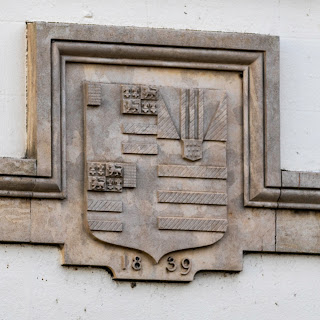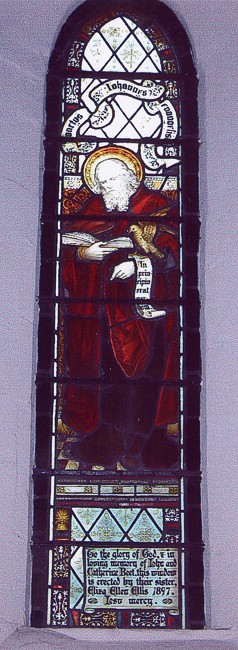The name 'Upton' literally means "Up town" as the village sits on a hill top commanding a grand view over the Trent valley with the beautiful Southwell Minster only a couple of miles to the west.
Upton has a close artistic community with at least six artists taking part in the annual Open Studios Notts event. This is a wonderful way to spend a day: wandering round this lovely village, popping in to chat with local artists, viewing their work and ending with tea and cakes in a local café or a pint in the pub beer garden. Unfortunately the event was cancelled for 2020 but follow the link above and you can enjoy a virtual tour.
Here is Upton Church by Susan Isaac:
We began our visit at Upton Hall home of the British Horological Institute. The Museum of Timekeeping is usually open to the public (but closed due to Corona Virus at the moment). It holds some quite beautiful timepieces (the watch worn by Captain Scott on his final polar expedition in 1912, for example) and there are fascinating bits of information to pick up (Were you aware that the H in H Samuel the famous jeweller stands for HARRIET? No, me neither!). The Institute holds special events throughout the year, plus courses and there is an extensive specialist library for researchers (open by appointment only).
The Hall was built in 1828 for Nottinghamshire banker, Thomas Wright (1773 - 1845). Wright was an amateur landscape painter and an avid art collector so the Hall was designed to house his paintings. Wright was a patron of J M W Turner and had such an interest in Richard Wilson he wrote a biography of the artist which he published in 1824.
In 1895 the property was purchased by John Warwick of 'Warwick and Richardson Brewers', Newark. There was obviously plenty of money to be made in beer ... the Warwicks overhauled the Hall by adding a Billiard Room, a Ball Room and six extra bed rooms.
John's father Richard Warwick had acquired a small brewery in 1856. This company merged with Trent Brewery in 1888; four years later they acquired their main Newark rivals, the Henry Jessop Brewery and the Cromwell Brewery; five years later they had moved further afield taking over the Doncaster company of Eadon and Co before then buying out Morris Rutland of Oakham. Their empire continued to grow until the 1950 when the brewery and around 100 pubs were bought out by John Smith's of Tadcaster who, unfortunately, stopped trading in 1966.
A memorial to Lt John Cedrick Warwick can be found in the village church.
He had been stationed in the Middle East but was returning to France on board the Leasowe Castle when it was torpedoed by a German submarine at 1.30am on 27th May 1918. Help was at hand as they were travelling in a convoy of six transporters and accompanied by a number of destroyers. The men on board remained calm by all accounts as the ship remained a afloat and the rescue was going smoothly. Unfortunately a bulkhead on the aft side of the ship gave way very suddenly and those remaining on the ship had to jump for their lives. Of the 2,900 men and crew on board 102 were lost to the sea. Lt Warwick's body was never recovered.
During the 1930s Upton Hall became the home of another bereft father: Sir Albert Ball, father of the more famous Albert Ball VC, First World War fighter pilot and flying ace who crashed to his death in France on 7th May 1917 aged just 20. He had gained such a reputation for his bravery that even his German enemy acknowledged "He was by far the best English flying man."
For a while Upton Hall became a Roman Catholic College for missionaries but since 1972 it has been the HQ of the British Horological Institute.
The Cross Keys is a welcoming, traditional country pub with a beer garden. They serve real ale and good food (again it is closed at the moment due to the virus).
We wandered through the village and found the 13th century church of Saint Peter and Saint Paul.
The Oglethorpes were the pre-eminent family of the village during the fifteenth century and several family members are buried inside the church. Unfortunately their memorials have been concealed due to different renovations over the centuries.
Owen Oglethorpe (1502 - 1559) was a prestigious member of this family. Not many people know his name but he played a very important part in English history.
He studied at Magdalen College Oxford before becoming Rector at Saint Peter's Church East Bridgford. He could not have given much pastoral care to this Nottinghamshire congregation however because he was also one of King Henry VIII's chaplains as well as being Canon at both Saint George Chapel Windsor and Christ Church Oxford. He was an incredibly busy man as any spare time was taken up laying the foundations for the newly formed Church of England. He was one of a select group of clergy chosen to debate theology with Archbishop Thomas Cranmer, Bishop Hugh Latimer and Bishop Nicholas Ridley … all three of whom were known as the Oxford Martyrs as they were burnt at the stake by Queen Mary I for their Protestant views. Oglethorpe was not quite as rigid in his opinions and Mary promoted him to Bishop.
Three weeks later Oglethorpe had to officiate at Queen Elizabeth's coronation service in West Minster Abbey. Apparently he was trusted to place the crown upon the royal head but the communion service was entrusted to someone else to ensure Elizabeth was not embarrassed a second time.
Oglethorpe refused to swear the Oath of Supremacy (acknowledging Queen Elizabeth as Head of the Church) and was deprived of his see. He died at the age of 49 a few months later.
In 1840 he became the mineralogist to Queen Victoria and supervised the cutting of the Koh-I-Noor diamond (one of the largest cut diamonds in the world).
There was a great deal of excitement when Tobias Matthew visited Upton in 1603. They threw a street party.
In 1609 - 1610 the village was struck by the plague. The population of around 300 was reduced over a short period with 110 burial recorded in the parish register.
The village squire, yet another Owen Oglethorpe, fled from the village but died at Blidworth.
A famous daughter of Upton is Fiona Thornewill who set a record of 42 days for walking to the South Pole alone and unaided. An outstanding achievement made even more remarkable by the fact she lost her satellite navigation system 10 days into the journey.
The village green is planted with apple trees …. Bramley Apple pie anyone?
Google map of Upton: click here.





































































